Gaeng Hung Lay is an iconic Northern Thai dish bursting with bold flavors. It's influenced by Burmese and Indian traditions and is a true celebration of Northern Thailand’s rich culinary heritage.
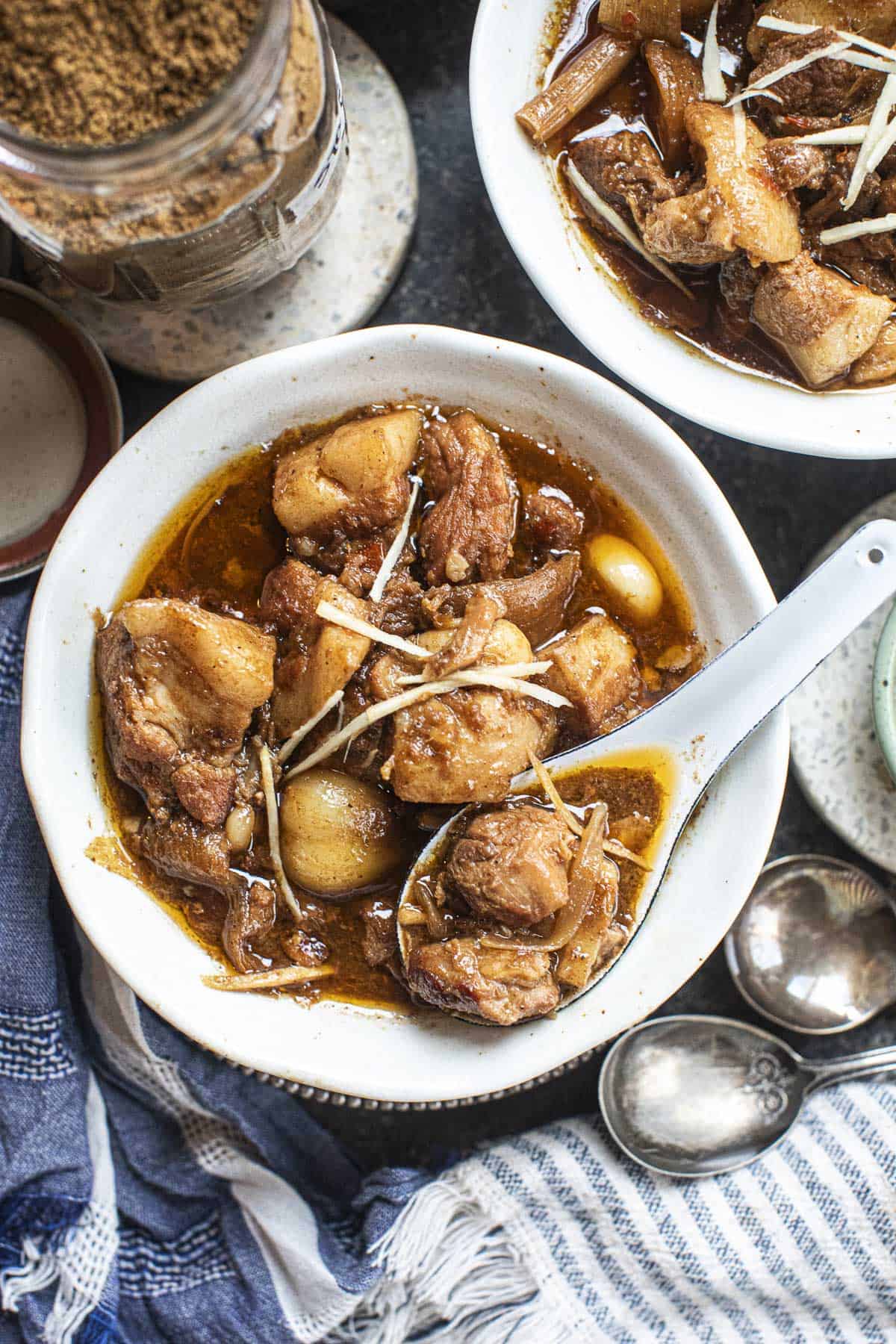
While I was testing this recipe for the blog, I made it two or three times to perfect the flavors. Usually, I don’t measure when I cook, but I meticulously measure everything for the blog so you can recreate the same mouthwatering results at home. I had plenty of leftovers during my testing, so I shared the curry with three families.
To my surprise, six people texted me right away, raving about how incredible it was! That's when I knew I needed to share this delicious dish! Gaeng Hung Lay isn’t commonly found in Thai restaurants in the U.S., so I’m thrilled to introduce it.
If you love pork belly, try this Moo Hong, a stewed southern pork belly recipe, Yellow curry with pork belly, Pad Prik King with pork belly, Easy Thai pork belly recipe, Kana Moo Grob pork belly with Chinese broccoli, or Chinese 5-spice pork belly.
Jump to:
- Hung Lay Curry – A Northern Thai Favorite
- What is Gaeng Hung Lay?
- Why You’ll Love Northern Thai Pork Belly Curry
- Ingredients for Gaeng Hang Lay Moo Recipe
- Hunglay Curry Paste
- Key Ingredients to Perfect Your Hung Lay Curry
- How to Make Gaeng Hung Lay
- How Do You Serve Hung Lay Curry?
- Tips for the Perfect Hung Lay Curry
- Variations and Substitutes
- Storage
- More Thai Curries You'll Love
- Frequently Asked Questions
- Gaeng Hung Lay (Northern Thai Pork Curry)
- More Pork Belly Recipes
Hung Lay Curry – A Northern Thai Favorite
My love for Hung Lay Curry stems from my firsthand experience growing up in Thailand, where this dish was served throughout the country, especially in the northern region during festive gatherings. It showcases the bold and vibrant flavors of Northern Thai cuisine.
Drawing on Thailand’s culinary heritage and my role as a recognized Thai cooking instructor, I present Gaeng Hung Lay Curry as a celebrated dish that reflects the depth and complexity of Northern Thai flavors influenced by Burmese and Indian traditions.
With years of experience teaching Thai cooking, I’ve fine-tuned the techniques to make this dish approachable for home cooks. From the tender pork belly to the tangy tamarind, every part of this recipe is designed to help you nail the authentic, complex flavors of Hung Lay Curry with confidence.
What is Gaeng Hung Lay?
Gaeng Hung Lay, or Hung Lay Curry, is a beloved Northern Thai dish with deep cultural and culinary significance, especially in Chiang Mai. In Thai, Gaeng means curry, and the dish is sometimes referred to as gaeng Hang Lay Moo, with Moo meaning pork.
This rich, aromatic curry features a tender, braised pork belly, a unique blend of spices, and a tangy note from tamarind juice. Influenced by Burmese and Indian cuisine, it carries a complexity of flavors that tell a story of regional history.
For my recipe, I use both pork belly and pork shoulder for the perfect balance of meatiness and richness, though you can opt for one or even substitute with pork ribs for a different take.
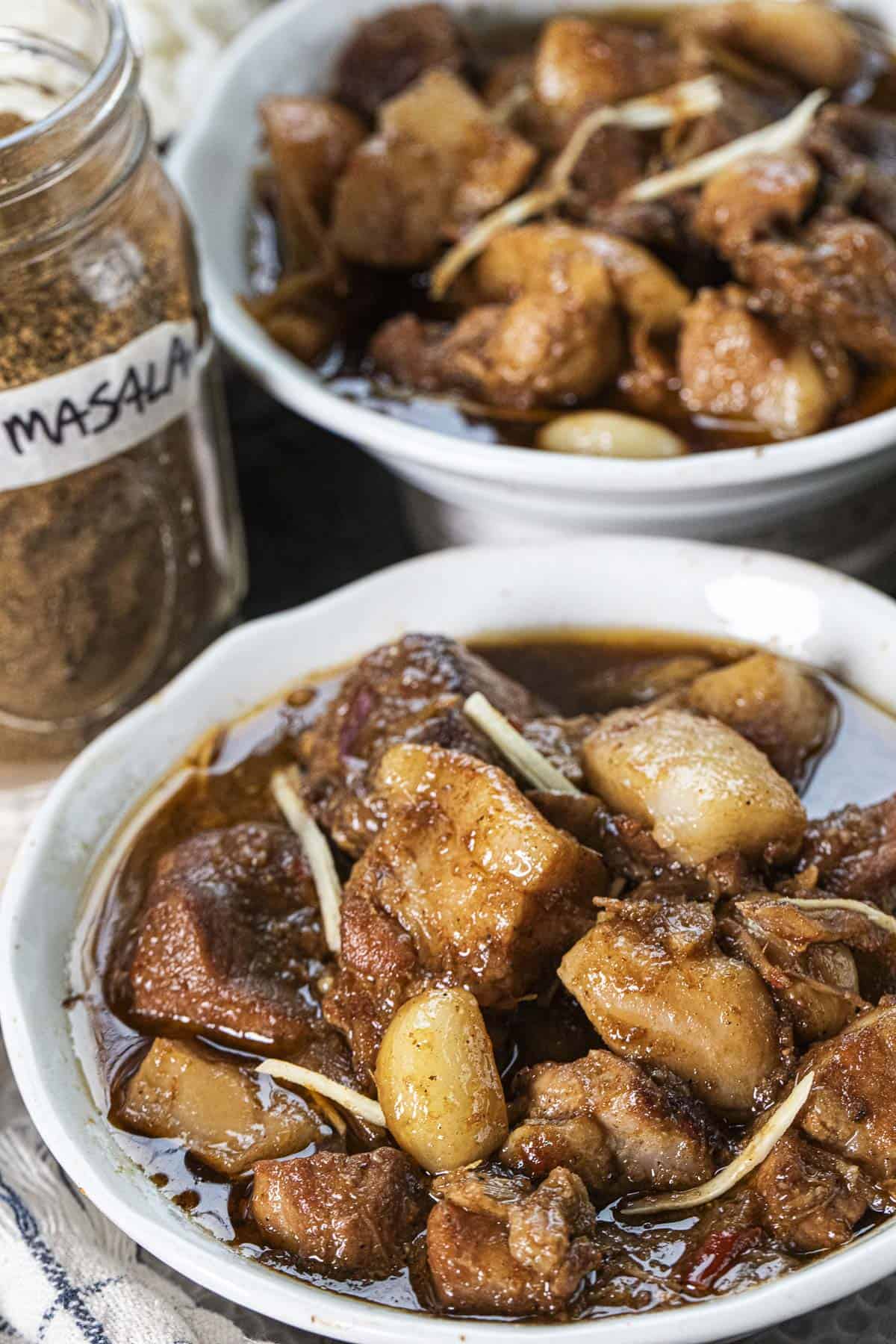
Why You’ll Love Northern Thai Pork Belly Curry
- Authentic Flavor: Packed with bold spices, tangy tamarind, and savory soy sauce.
- Tender Pork Belly: Slow-cooked until fork-tender melts in your mouth.
- Versatile Dish: Perfect with jasmine or sticky rice for a hearty meal.
- Unique Spices: Combines Thai, Burmese and Indian influences for a one-of-a-kind taste.
Ingredients for Gaeng Hang Lay Moo Recipe
Here’s everything you need to create this Thai Northern curry masterpiece!

- Pork belly pieces and pork shoulder. I opted for two cuts of pork mixture for the perfect balance of richness and meatiness.
- Gaeng Hung Lay paste is made from dried chilies, garlic, shallots, lemongrass, and more. See the recipe below.
- Water. You'll need several cups of water to use as the base for the curry, which is used to braise the meat until it is tender.
- Pickled garlic. Whole garlic is pickled in a briny, sweet, tangy liquid. It is used in Thai food to add sweetness and tanginess to dishes. It is sold in the Asian market. Please see the image below for reference.
- Pickled garlic juice. The liquid from the pickled garlic. It's used for added tanginess.
- Fresh garlic and shallots: Essential for depth of flavor. Hunglay uses a lot of garlic, so be mindful of this. I use large garlic cloves as I love garlic in my cooking! Adapt as needed for your preference. (:
- Fresh ginger is one of the unique flavors of Hung Lay. Young ginger is typically used in Thailand, but they are difficult to find in the North American continent.
- Tamarind concentrate or tamarind pulp. Provides a signature tang. Make your own tamarind pulp using this recipe.
- Dark, sweet soy sauce. Adds a dark brown color with rich, sweet, caramelized flavors. *This is important* Don't confuse it with the unsweetened black soy sauce. Please see the notes below.
- Fish Sauce. I used Squid brand for my recipe.
- Sugar. For a sweetener, use palm sugar, paste, or the palm sugar (in pug form). Brown, white, or even agave sugar will work. Traditional Thai uses palm sugar.
- Garam masala. You can find store-bought Garam Masala in the dry spices section of Asian, Indian, and Middle Eastern markets. This is one of the brands I like.
Hunglay Curry Paste
Please see the recipe card below for Hung Lay Paste ingredient measurements.
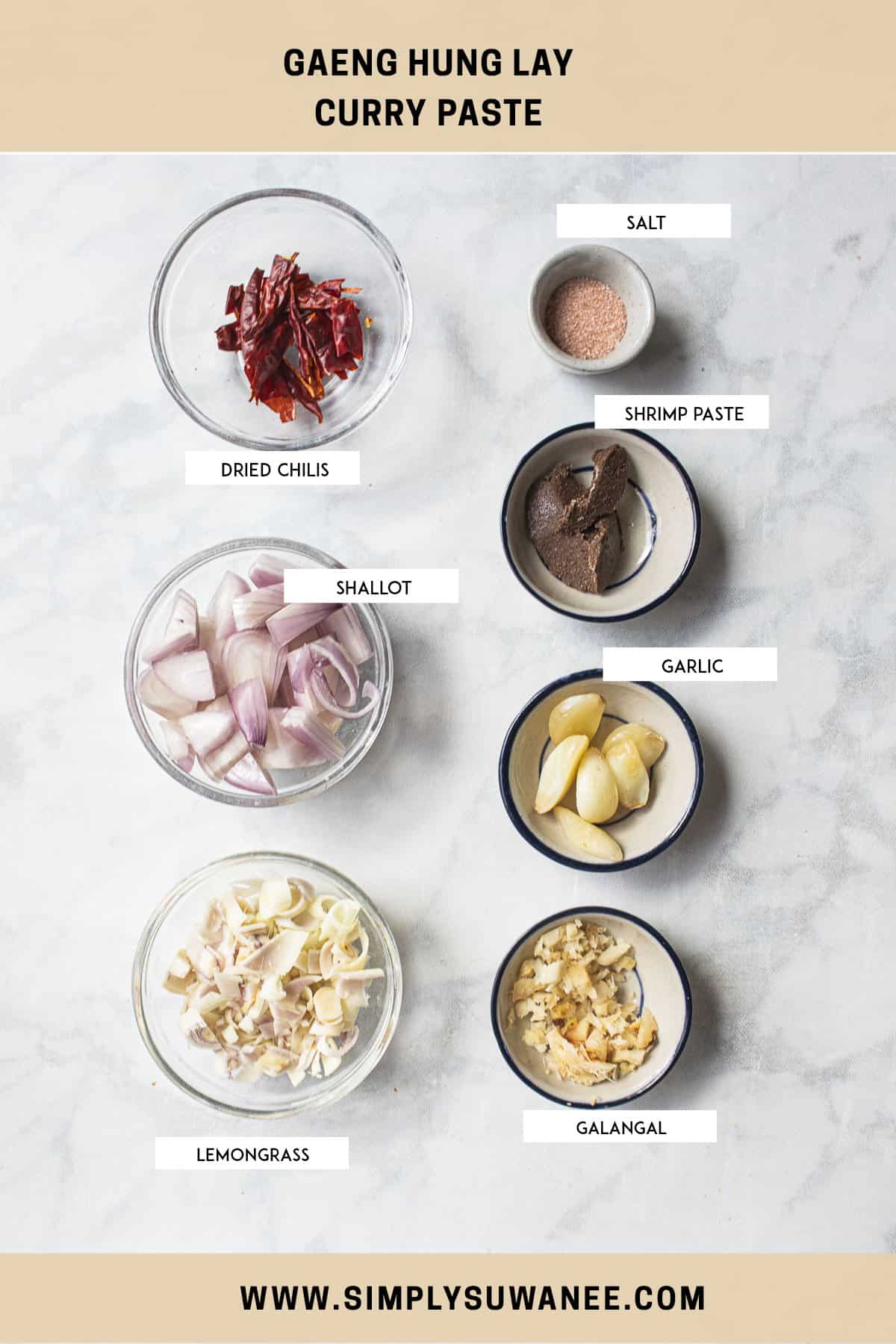
To make Hung Lay curry paste, use a stone mortar and pestle or a spice grinder for the best texture, as a small food processor can be too large and cumbersome for this task. For a flavorful base, the paste combines dried chilies (adjust as needed for heat), garlic, shallot, galangal, lemongrass, salt, and shrimp paste.
Key Ingredients to Perfect Your Hung Lay Curry
To achieve the authentic flavors of Hung Lay Curry, three essential ingredients must be noted: pickled garlic, sweet dark soy sauce, and garam masala. I’ve included photos of the brands I use, all of which are available at most local Asian markets or online.
1. Pickled Garlic
This sweet and tangy garlic and its briny juice are used in the curry. Look for the variety with whole young garlic heads and stems. The stems are fibrous, so you can leave them intact during cooking, but remove them before eating. See the pictures below for reference.

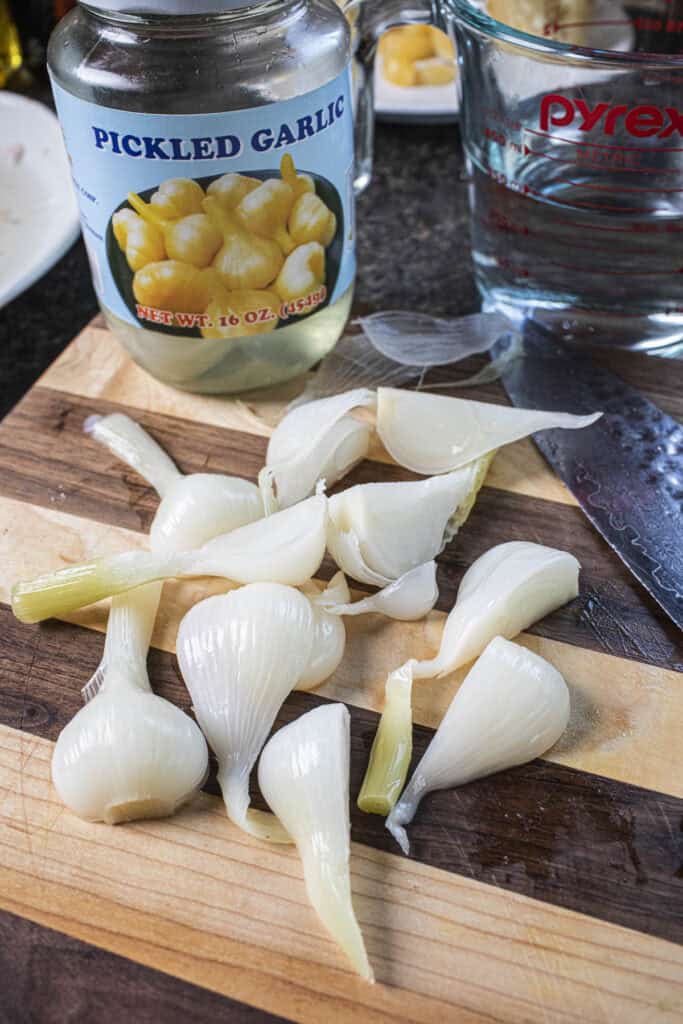
2. Sweet Dark Soy Sauce
Thai sweet dark soy sauce is different from regular dark soy sauce—it’s slightly sweet and adds a deep, caramelized color to the curry. Don’t confuse the two! Look for Healthy Boy brand sweet dark soy sauce at your local Asian market. I recommend this Healthy Boy brand sweet dark soy sauce. See the pictures below for reference and the brands I've used.
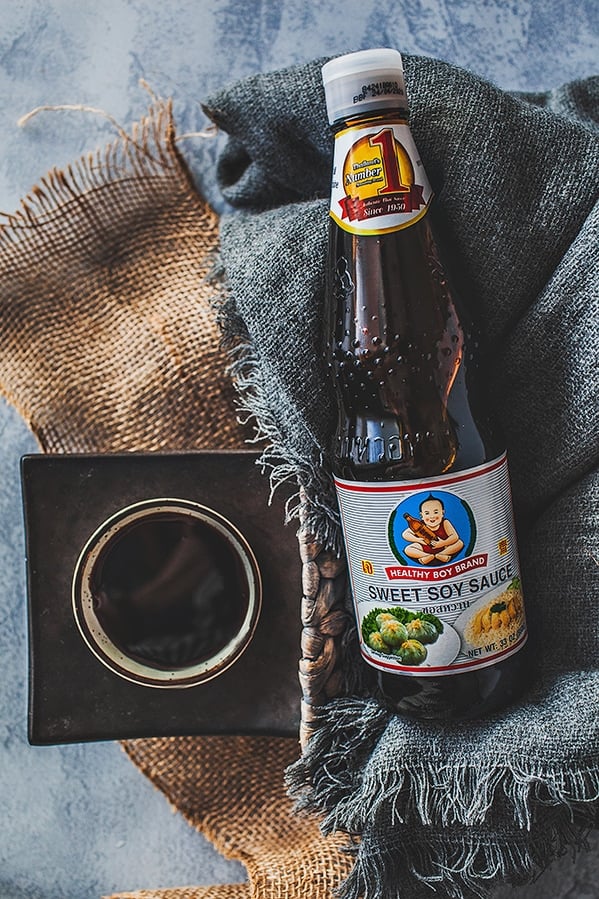

3. Garam Masala Powder
This fragrant spice blend combines toasted and ground spices like coriander, cumin, cardamom, cinnamon, cloves, and black pepper. You can find it at Asian markets or make your own using my friend Sylvia's easy Garam Masala recipe here.
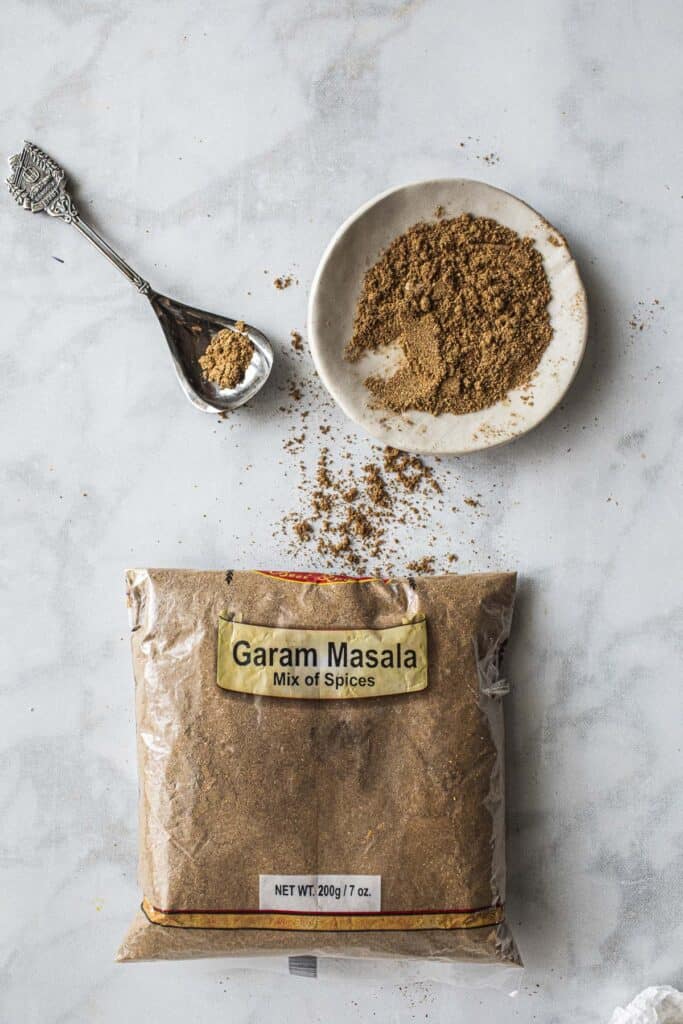
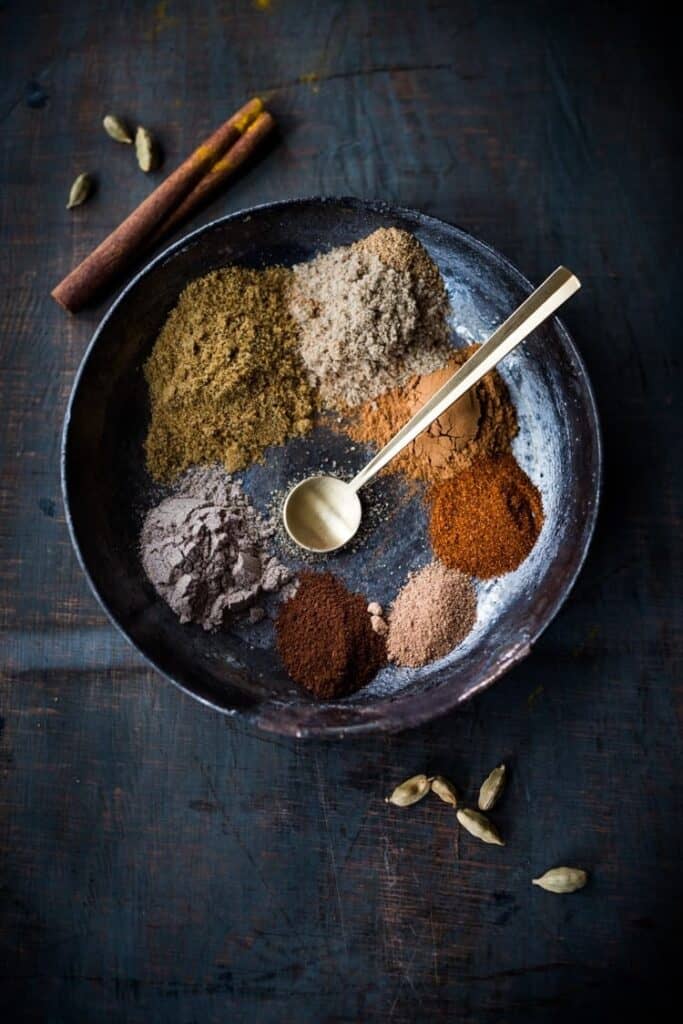
(Right Photo credit by Silvia Fountaine of Feasting at Home)
How to Make Gaeng Hung Lay
1. Prep the Ingredients: Let’s get everything ready! Soak your dried chilies in hot water for about 10-15 minutes. Add as many as you like, depending on how much heat you can handle. If you prefer mild, remove the seeds first to reduce the heat.
After soaking, chop the chilies into larger pieces to make pounding them easier.
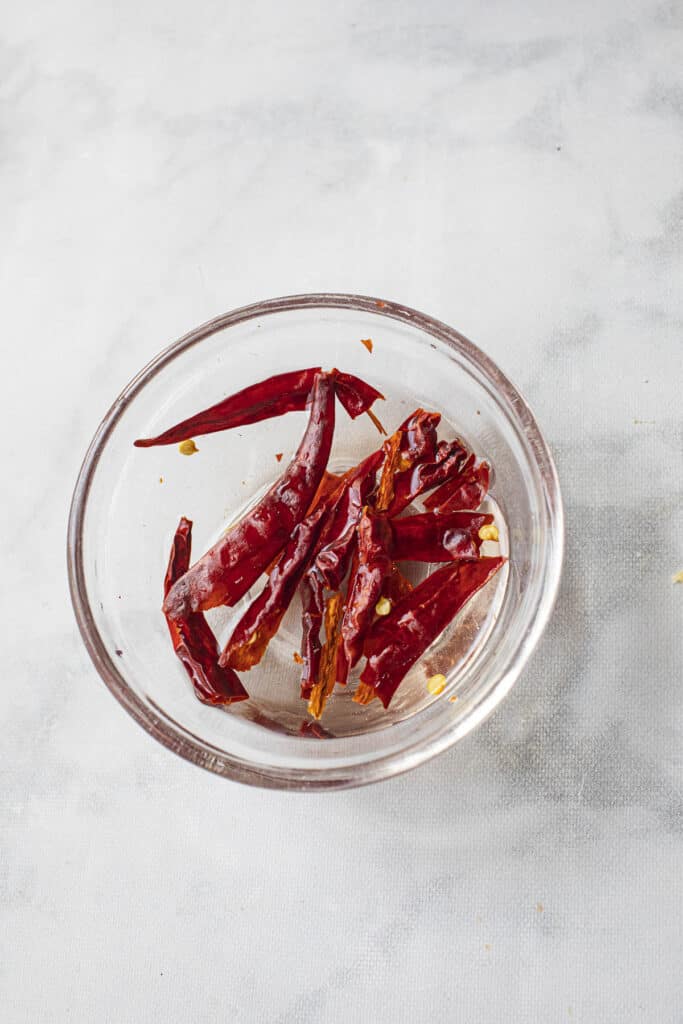
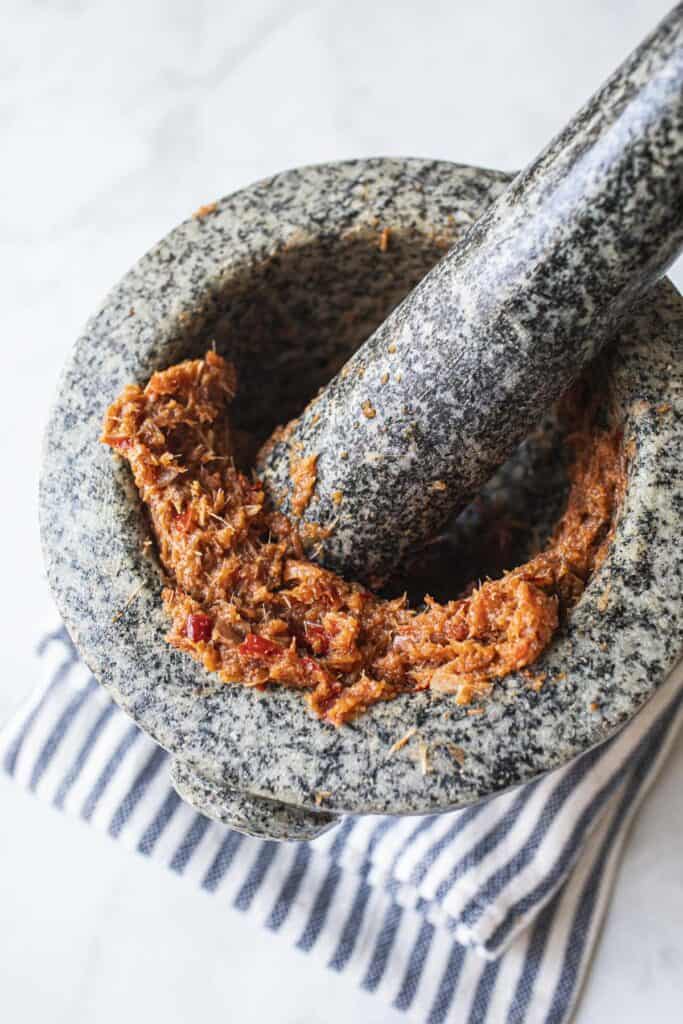
2. Make the Hung Lay Paste: Using a mortar and pestle, pound together the soaked chilies, lemongrass, galangal, garlic, shallot, and salt. Don’t rush—work in small batches of three ingredients at a time to make it easier on yourself. Add the shrimp paste last. No need for perfection here; a slightly rough paste is totally fine for this dish if you like the smooth paste. Pound or grind until you love the consistency.
3. Sauté the Paste: Heat a large pot or Dutch oven over medium heat. Add a tablespoon of oil, then sauté your paste for a couple of minutes or until fragrant and your kitchen smells amazing. Stir it often with a wooden spatula so nothing burns.

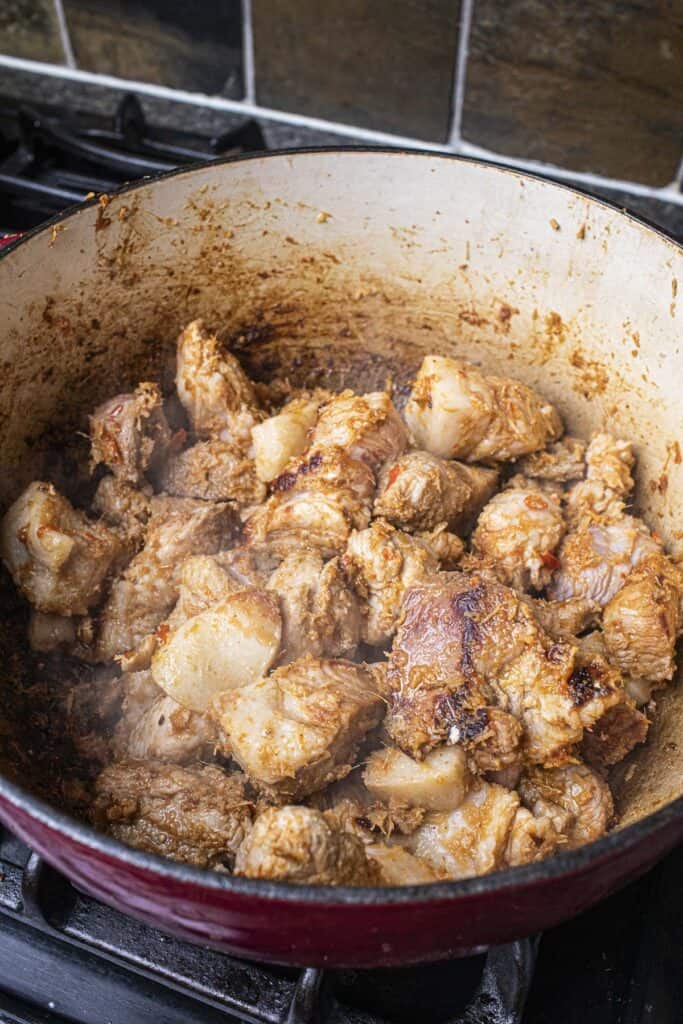
4. Brown the Pork: Turn the heat up to medium-high, toss in the pork, and coat every piece in that fragrant paste. Let it cook for 3-4 minutes until lightly browned. If things start sticking or burning, just splash around ⅓ cup of water to loosen it up and keep all those yummy flavors in the pot.
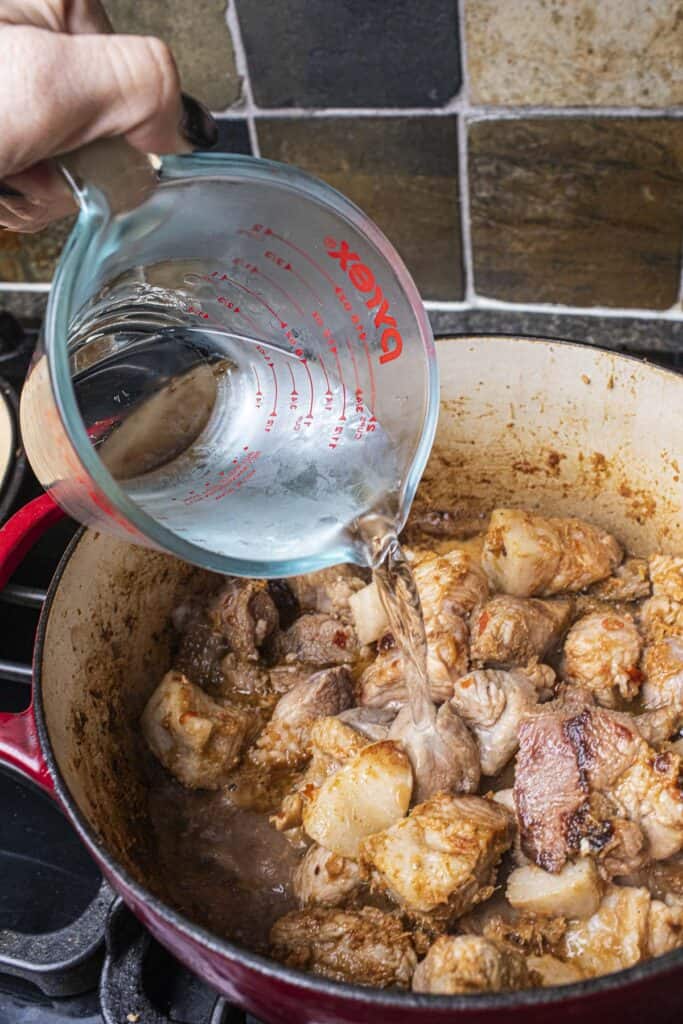

5. Simmer the Curry: Pour in the remaining water, add the salt and garlic juice, and give it a good stir. Bring it all to a boil, then lower the heat to a gentle simmer. Cover and let it cook for 1.5-2 hours.

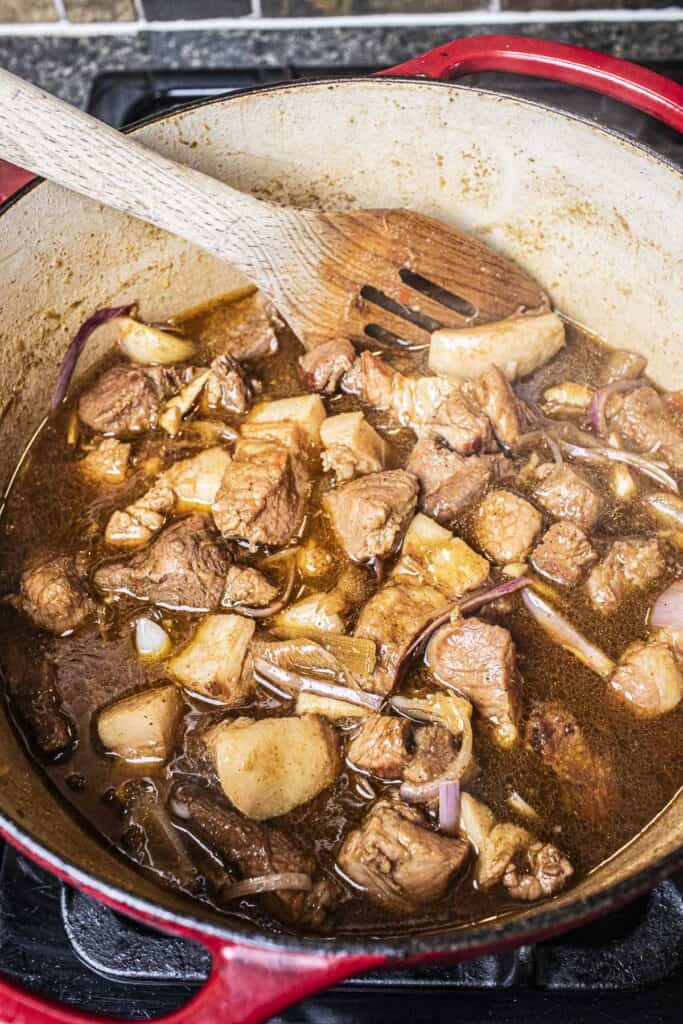
6. Add Final Ingredients: After an hour, toss in the remaining ingredients. Give it another stir, and continue simmering until the pieces of pork are fork tender and the sauce is just how you like it. Serve and Enjoy the amazing dish you just created!
How Do You Serve Hung Lay Curry?
Serve Gaeng Hung Lay with steamed jasmine rice or traditional sticky rice. Pair with fresh vegetables or a simple side salad to balance the richness. Garnish with fresh cilantro or green onions for added freshness.

Tips for the Perfect Hung Lay Curry
- Cut pork into large chunks to keep the meat intact during the long braising process.
- Cheat for a reddish hue: If you prefer less heat, use sweet red bell peppers instead of dried chilies. I do this for my kids to give the illusion of spiciness, and the natural red color is so pretty!
- Simmer low and slow: Allow the curry to cook on low heat for the flavors to develop fully.
- Enhance depth: Let the curry rest overnight before serving. The flavors will deepen the next day, making it taste even better.
- Reduce pork fat: Swap pork loin for a leaner option if you prefer less fatty cuts.
Variations and Substitutes
- Spice Level: Adjust the heat level according to your taste buds by using more dried chilies with seeds still in, or add more of the Hung Lay paste for extra spiciness!
- Vegetarian options. You can adapt Kaeng Hung Lay for a vegetarian version by adding firm, large pieces of tofu and your favorite veggies. Please note that tofu doesn't take as long to cook, so I would only braise it for one hour or less. Using fried tofu is best. Here's my recipe for an easy, deep-fried tofu.
- Meat Substitutes: Use chicken thighs or beef instead of pork, opting for fattier cuts for a richer flavor.
Storage
- Leftovers can be refrigerated in an airtight container for up to 3 days or frozen for up to 3 months. To retain flavor, they should be reheated slowly on the stovetop.

More Thai Curries You'll Love
- Moo Hong, Thai southern pork belly
- Thai Massaman Curry
- Northern Thai Khao Soi
- Thai Green Curry with Chicken
- Authentic red curry with chicken
- Thai chicken with kabocha squash
Frequently Asked Questions
Traditional Hang lay curry doesn't have vegetables, but green beans, onion, bamboo shoots, bell peppers, broccolini, and zucchini are great options if you want to make a vegetarian version. Remember not to cook them too long to prevent mushiness.
No, this Northern Thai curry requires a specific flavor profile to be authentic. Red curry has a different flavor profile. Making your own Hang Lay paste is easier. It's worth the little effort to try memorable flavors that you'll love.
The use of Garam Masala, the Hung Lay paste, aromatic herbs, seasoning, and slow cooking gives it a distinct tangy and savory flavor, making Hung Lay one of the most iconic dishes of northern Thailand.
**Thank you for visiting! Sharing these recipes is my passion, and I’d be thrilled if you’d pass them along to friends—your support means the world!**
Print
Gaeng Hung Lay (Northern Thai Pork Curry)
- Total Time: 2 hours 30 minutes
- Yield: 6 servings
Description
Gaeng Hung Lay is an iconic Northern Thai dish bursting with bold flavors. It's influenced by Burmese and Indian traditions and is a true celebration of Northern Thailand’s rich culinary heritage.
Ingredients
- 3 pounds of pork belly and pork shoulder cut into 3-inch pieces. I opted for two 1.5-pound cuts each of pork belly and pork shoulder.
- ½ cup Gaeng Hung Lay paste. Recipe below. The recipe below makes slightly less than 1 cup of the paste, but feel free to use the entire thing if you want a bolder-flavored curry.
- 5 ½ cups water. Add up to 1 cup extra if your curry dries out too much.
- 3 large pieces of pickled garlic sliced in halves.
- ½ cup pickled garlic juice. The liquid from the pickled garlic. It's used for added tanginess.
- 8 large cloves fresh garlic. Hunglay uses a lot of garlic, so be mindful of this. I use large garlic cloves as I love garlic in my cooking! Adapt as needed for your preference. (:
- ⅓ cup shallots chopped small.
- ⅓ cup Fresh ginger sliced into long match stick pieces.
- ⅓ cup tamarind concentrate.
- 1 tablespoon dark, sweet soy sauce. *This is important* Don't confuse it with the unsweetened black soy sauce. Please see the notes below.
- 2 teaspoon fish sauce. I used Squid brand for my recipe.
- ⅓ cup sugar. Use palm, brown, white, or even agave. Traditional Thai uses palm sugar.
- 1 ½ tablespoon Garam Masala. You can find store-bought Garam Masala at the Asian markets in the dry spices section. If you are feeling adventurous, use my friend Silvia's recipe here.
Hung Lay Curry Paste
- 8-15 dried Thai chilies (use as needed for your spice level). I used 7 Thai long peppers with seeds removed.
- 10 cloves garlic
- ⅓ cup shallot
- 1 tablespoon chopped galangal
- 3 stalks of lemongrass, about ⅓ cups
- 1 teaspoon salt
- 2 teaspoon shrimp paste
Instructions
- Prep the Ingredients: Let’s get everything ready! Soak your dried chilies in hot water for about 10-15 minutes. Add as many as you like, depending on how much heat you can handle. If you prefer mild, remove the seeds first to reduce the heat. After soaking, chop the chilies into larger pieces to make pounding them easier.
- Make the Hung Lay Paste: Using a mortar and pestle, pound together the soaked chilies, lemongrass, galangal, garlic, shallot, and salt. Don’t rush—work in small batches of three ingredients at a time to make it easier on yourself. Add the shrimp paste last. No need for perfection here; a slightly rough paste is totally fine for this dish. If you like the smooth paste, pound or grind until you love the consistency.
- Sauté the Paste: Heat a large pot or Dutch oven over medium heat. Add a tablespoon of oil, then sauté your paste for a couple of minutes or until fragrant and your kitchen smells amazing. Stir it often with a wooden spatula so nothing burns.
-
Brown the Pork: Turn the heat up to medium-high, toss in the pork, and coat every piece in that fragrant paste. Let it cook for 3-4 minutes until lightly browned. If things start sticking or burning, just splash around ⅓ cup of water to loosen it up and keep all those yummy flavors in the po
- Simmer the Curry: Pour in the remaining water, add the salt and garlic juice, and give it a good stir. Bring it all to a boil, then lower the heat to a gentle simmer. Cover and let it cook for 1.5-2 hours.
- Add Final Ingredients: After about an hour, toss in the remaining ingredients, give it another stir, and continue simmering until the pieces of pork are fork tender and the sauce is just the way you like it. Serve and Enjoy the amazing dish you just created! Serve Gaeng Hung Lay with steamed jasmine rice or traditional sticky rice.
Notes
- Cut pork into large chunks to keep the meat intact during the long braising process.
- Cheat for a reddish hue: If you prefer less heat, use sweet red bell peppers instead of dried chilies. I do this for my kids to give the illusion of spiciness, and the natural red color is so pretty!
- Simmer low and slow: Allow the curry to cook on low heat for the flavors to develop fully.
- Enhance depth: Let the curry rest overnight before serving. The flavors will deepen the next day, making it taste even better.
- Reduce pork fat: Swap pork loin for a leaner option if you prefer less fatty cuts.
- Prep Time: 30
- Cook Time: 2 hours
- Category: Pork Recipes
- Method: Braised
- Cuisine: Thai
***Did you make this recipe? Please rate and review this recipe in the comment section below so I can improve and make it a better experience for you!***
More Pork Belly Recipes
Looking for other recipes like this? Try these tasty pork belly recipes.


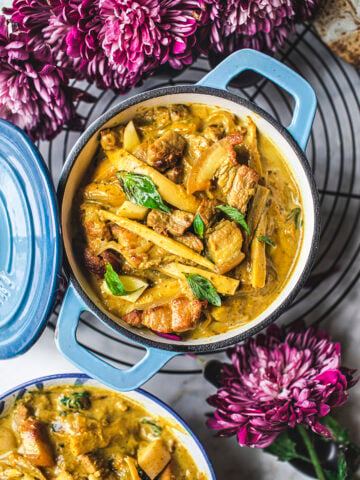






Suwanee says
Indeed! It's the perfect holiday dish. Thank you, Amanda!
Amanda says
Such an amazing dish! Reminds me of Christmas with the warm spices and belly-hugging depth of flavors. Worth the work!
Phoebe says
One of my favorite dishes I have tried! Perfect amount of spice, for me. Only downside was I had to share 🙂
Suwanee says
Thank you, Jeff! So delighted you loved it so much! (:
Jeff Webb says
I was one of the 6 people that texted Suwannee after eating this dish. It’s exceptional. Absolutely delicious. I will be trying to make it myself soon!
Tami says
This dish is so delicious and I love Suwanee's detailed recipes explaining how to make other tasty Thai dishes. I cannot wait to replicate this in my own kitchen!